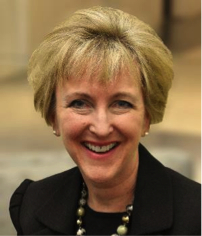
Sonja Gibbs is Senior Director of the Capital Markets and Emerging Markets Policy Department of the Institute of International Finance (IIF) and her research interests include global trade and capital flows, systemic risks in financial markets, banking sector analysis, emerging/frontier markets, and investing in infrastructure and green finance. Her work on policy includes issues related to the G20 and the international financial institutions. She co-authors a number of regular IIF publications including the Weekly Insight, the monthly Capital Markets Monitor, and the quarterly Capital Flows to Emerging Markets.
 Sonja has spent over 20 years in banking and financial markets, most recently with Nomura International in London, where she was Chief Equity Strategist. Previously she was Head of East European Economics and Senior European Bond Analyst, also for Nomura. Earlier positions included stints as a bank credit analyst and U.S. economist for First Interstate Bank Los Angeles, and IBJ New York. She has taught undergraduate microeconomics at U.C. Berkeley, and spent several years as a researcher with the Berkeley-Stanford Program on Soviet International Behavior.
Sonja has spent over 20 years in banking and financial markets, most recently with Nomura International in London, where she was Chief Equity Strategist. Previously she was Head of East European Economics and Senior European Bond Analyst, also for Nomura. Earlier positions included stints as a bank credit analyst and U.S. economist for First Interstate Bank Los Angeles, and IBJ New York. She has taught undergraduate microeconomics at U.C. Berkeley, and spent several years as a researcher with the Berkeley-Stanford Program on Soviet International Behavior.
- What are three trends ahead for green finance?
Over the next few years, I think we are likely to see a sea change in the way we look at green finance.
- Beyond bonds, beyond green: The green bond market is well launched and continues to expand rapidly—notably in the sovereign and sub-sovereign space in 2017-2018. However, other instruments are making significant headway. Green loans are moving beyond large corporate borrowers: extending to small and medium-sized enterprises (SMEs) and even to households. Two big growth areas are green mortgages and green loan securitization; securitization in particular will provide more opportunities for institutional investors to “size up” the funding they are able to commit to green finance. And beyond green finance targeting the “E” of ESG investing (i.e, environment, social and governance factors used to evaluate the sustainability of an investment), there is a growing focus on social and governance issues. Indeed, 2017 also saw the launch of a set of Social Bond Principles, developed along the lines of the existing Green Bond Principles. The World Bank launched the first-ever SDG-linked bond last year, to support projects contributing directly to the Sustainable Development Goals. So going forward, we’d expect to see continued progress on E—but with growing emphasis on the S and the G. Against this backdrop, we would expect more regulatory innovation along the lines of the EU Action plan as both policymakers and regulators look to facilitate sound market development.
- Green infrastructure—watch this space: not only is much more private sector money being channeled to infrastructure investment, but sustainability is becoming an integral part of the planning process as climate change transforms our communities—think green buildings, or a stormwater management project that protects the natural water cycle. Taking it a step further, “smart cities” integrate information, communication and transportation technology to optimize the efficiency of city operations, including by reducing resource consumption. Cities like New York, San Francisco, London, Paris, and Tokyo are making great strides—e.g. in the use of electrical grids running on renewables, solar panels, biomass plants, internet access and government digitization. Smart cities such as Copenhagen, Singapore and Stockholm are setting new standards for urban planning and the use of big data to address problems such as traffic congestion and pollution. More than 500 Chinese cities have begun or are planning smart-city transformations. Over the next decade, the number of smart cities in the world is expected to explode—and not just in wealthy or middle-income countries. Public-private partnerships will remain a particularly effective means of financing this transformation.
- Investors are taking action: Given the breadth of their holdings, institutional investors remain very exposed to longer-term risks of climate change. At the same time they are particularly well positioned to invest in sustainable solutions, given long-term investment horizons and deep pools of capital. Impact investment is on the rise: by some measures, fully 25% of global AUM—over $22 trillion—can be counted as sustainable. Asset managers are moving away from viewing impact investment as a niche; rather ESG strategies will continue to be integrated across the spectrum of asset classes and into investment processes. Beyond the traditional negative screening (avoiding investments with undesirable ESG associations), more positive strategies—integrating ESG data as part of fundamental analysis, or selectively favoring investments with strong ESG performance—are set to grow in popularity. Asset owners—including pension funds, sovereign wealth funds, and endowments will also be driving this change, by increasing ESG allocations, divesting from fossil fuels, and by their choice of third-party investment managers. This “mainstreaming” of green and sustainable finance will increasingly be driven by individual investors—most notably millennials—actively seeking change.
- China prioritized green finance in its 2016 G20 year and the work has continued at the G20 level. As the G20 chair for 2018, Argentina has committed to advancing G20 work. What progress do you foresee for the G20 on green finance this year?
The Argentine government has already made significant progress on green finance, with the G20 Sustainable Finance Study Group engaged in three substantive workstreams—securitization of sustainable assets, development of sustainable private equity and venture capital, and digital innovation for mobilizing sustainable finance. These well-targeted initiatives will all help scale up sustainable finance: securitization will expand the opportunity set for large institutional investors; private equity and venture capital can provide very large pools of capital, including for green infrastructure, and digital innovation will help target and expand funding to combat environmental risks, taking forward the work of the Green Digital Finance Alliance launched in early 2017.
- The IIF’s vast membership covers major swaths of the finance industry from global financiers to private hedge funds. Based on varied roles and scopes in the industry, is there consensus or dissonance among members on the concept of green finance?
The concept of green finance is broad, and there are certainly differences of opinion around definitional issues and taxonomy. For this reason, one of the first priorities of the IIF Sustainable Finance Working Group will be to contribute to efforts to build a coherent taxonomy across jurisdictions, including the initiative set out in the European Commission Action Plan on Sustainable Finance. Such a taxonomy—in the context of an effective and supportive regulatory framework—will help scale up sustainable finance practices.
- The international financial markets have seen much activity in the green bonds space with the U.S and China both very active in green bond issuances in 2017–$43.1 billion and $23.1 billion respectively. What trajectory do you expect for green bonds for the U.S., for China, and globally?
Trends in the first half of 2018 suggest that the green bonds market continues to gain momentum, with more issuance from a broader range of sovereigns as well as multilateral, sub-sovereign and corporate issuers. Structures are becoming more sophisticated, broadening the range of available instruments and appealing to a wider investment base. Recent surveys suggest that more than 75% of global asset owners now feel they have a responsibility to address global sustainability through their investments—a growing source of demand for green bonds and securities. Green infrastructure opportunities will also help bring in a wider range of investors—in China this year, for example, a notable proportion of green bond proceeds has targeted green buildings. Policy initiatives—notably in China, EM Asia and Europe—are also targeted at expanding the green bond market. We look for the green bond market to grow rapidly in the years to come, and hope that the work of the IIF Sustainable Finance Working Group can help bring together public and private sector initiatives to help make this happen.
- Which living person do you most admire and why?
In the context of sustainable finance, I find it difficult to make the case that a single person should capture the lion’s share of admiration—in fact, in our field, collective effort is the only way forward. That said in terms of inspiration I’d certainly cite Michelle Obama for any number of reasons—turning the traditional behind-the-scenes role of First Lady into a strong leadership position, taking on controversial issues, for tackling fundamental problems like nutrition and childhood obesity via her Let’s Move! program, outreach on education (Reach Higher Initiative, Let Girls Learn), and her support for gender equality. And really, how can you help but admire a woman who will bust a move with Ellen DeGeneres on national television—what better way to promote awareness of the need for physical fitness.


